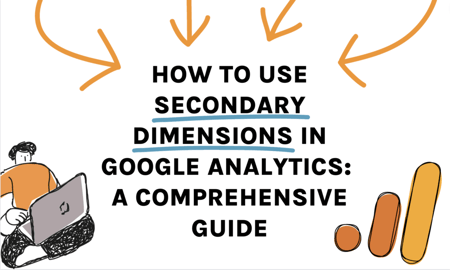Enhancing Search Engine Optimization Performance with Secondary Dimensions: Ideal Practices
Enhancing Search Engine Optimization Performance with Secondary Dimensions: Ideal Practices
Blog Article
Transform Your Information Recognizing With Secondary Measurements
Discovering information with the lens of secondary dimensions opens up a world of untapped insights, offering an extra nuanced viewpoint on the details of your dataset. By untangling the layers underneath the surface metrics, you can reveal patterns and partnerships that may have otherwise gone undetected, paving the means for notified decision-making and strategic optimizations. This calculated use of additional dimensions not only improves your information understanding yet additionally functions as a catalyst for unlocking the complete possibility of your analytics endeavors.
Benefits of Secondary Measurements

Second dimensions likewise make it possible for businesses to carry out even more comprehensive efficiency assessments. By layering added dimensions onto existing information, organizations can examine the impact of numerous variables on essential metrics, assisting them make even more educated choices. Furthermore, additional measurements promote the recognition of brand-new opportunities for optimization and growth by uncovering connections that may have or else gone undetected. Generally, the application of second dimensions leads to much more durable and informative information evaluation, encouraging businesses to drive strategic actions based on a much deeper understanding of their information.

Just How to Execute Additional Measurements
To efficiently carry out additional measurements in information analysis, companies must initially identify essential variables that line up with their logical objectives and objectives. This involves determining the details metrics and dimensions that are most relevant to the understandings they seek to obtain from the data. Once these essential variables are recognized, organizations can after that choose the suitable additional measurements to improve their evaluation further. It is important to take into consideration how these secondary dimensions will certainly give additional context and depth to the main data being evaluated.

Analyzing Data With Additional Measurements
Utilizing additional measurements in data evaluation improves the depth and context of understandings stemmed from primary data. By including additional measurements right into your analysis, you can get a more comprehensive understanding of the connections and patterns within your information. This procedure includes examining the key data with various lenses or perspectives, which can disclose hidden relationships or fads that may not be promptly apparent when assessing the data using just primary dimensions.
Assessing data with secondary measurements permits you to section and team your data in numerous methods, supplying a more nuanced view of your dataset. secondary dimensions. This division can assist you identify certain variables that may be influencing the end results you are studying. By drilling down into the information using additional dimensions, you can discover useful insights that can lead decision-making and strategy development
Ideal Practices for Second Dimensions
When incorporating additional measurements into data analysis, precision in visit the website specifying the dimensions is important for removing significant understandings. It is crucial to select secondary dimensions that enhance the key information properly.
An additional finest technique is to prevent redundancy in dimensions. Make sure that the secondary dimensions add new perspectives or information to the analysis, as opposed to duplicating information currently present in the key dimensions. This will help prevent confusion and enhance the interpretation of the information.
Additionally, it is important to think about the scalability of the evaluation when picking additional dimensions. Choose dimensions that can be easily expanded or changed as needed to fit future information needs or changes in analytical emphasis. By adhering to these finest techniques, experts can make the most of the value of secondary dimensions in data analysis and gain much deeper understandings right into their datasets.
Maximizing Insights Via Second Measurements
Incorporating additional measurements purposefully improves information evaluation by supplying a deeper understanding of the connections within the dataset (secondary dimensions). By taking full advantage of insights with secondary measurements, experts can uncover important patterns, trends, and reliances that may not be quickly apparent when analyzing the information through main measurements alone
One key benefit of using secondary dimensions is the ability to segment and filter information more exactly. This segmentation permits a much more granular evaluation of particular subsets within the dataset, enabling experts to recognize connections and causations that could have otherwise been forgotten.
Additionally, second dimensions can aid in contextualizing key information points by including layers of info that offer an even more thorough view of the data. This contextualization is vital for making my link notified decisions based on an alternative understanding of the dataset.
Verdict
In final thought, incorporating second dimensions in data analysis procedures provides an extra nuanced and comprehensive understanding of information, causing improved insights and tactical decision-making. By integrating extra variables that align with analytical objectives, hidden trends and correlations can be disclosed, providing a much more comprehensive and contextualized view of information. This technique makes best use of the potential for optimization and reveals new opportunities within operations.
Generally, the use of secondary dimensions leads to a lot more durable and informative information analysis, equipping companies to drive tactical activities based on a deeper understanding of their information.
Using second dimensions in information evaluation boosts the depth and context of insights obtained from main information.Assessing information with secondary measurements enables you to sector and group your information in numerous methods, giving an extra nuanced view of your dataset.When including additional dimensions right into data evaluation, precision in specifying the measurements is important for extracting significant insights. next Guarantee that the second dimensions add new viewpoints or information to the analysis, rather than duplicating info currently existing in the key measurements.
Report this page